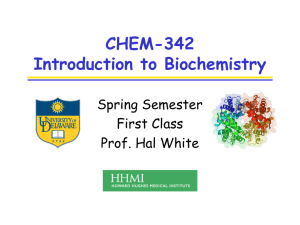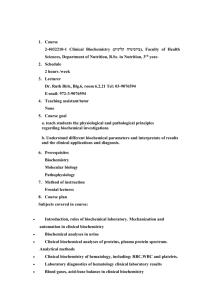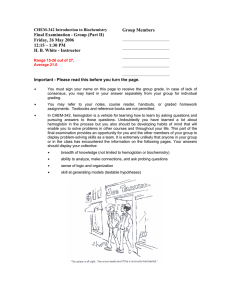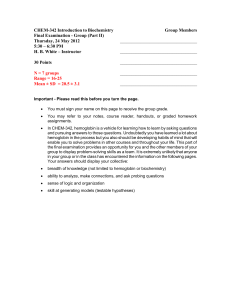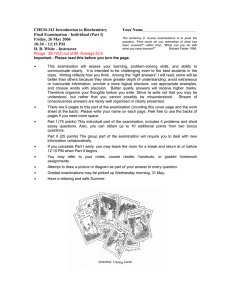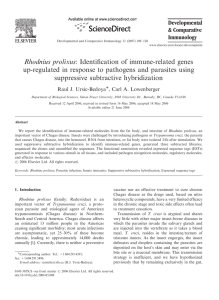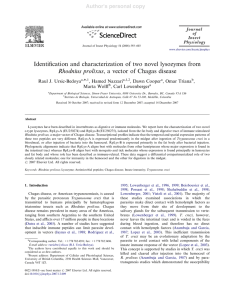Group Members Final Examination - Group Part Monday, 24 May 2004
advertisement
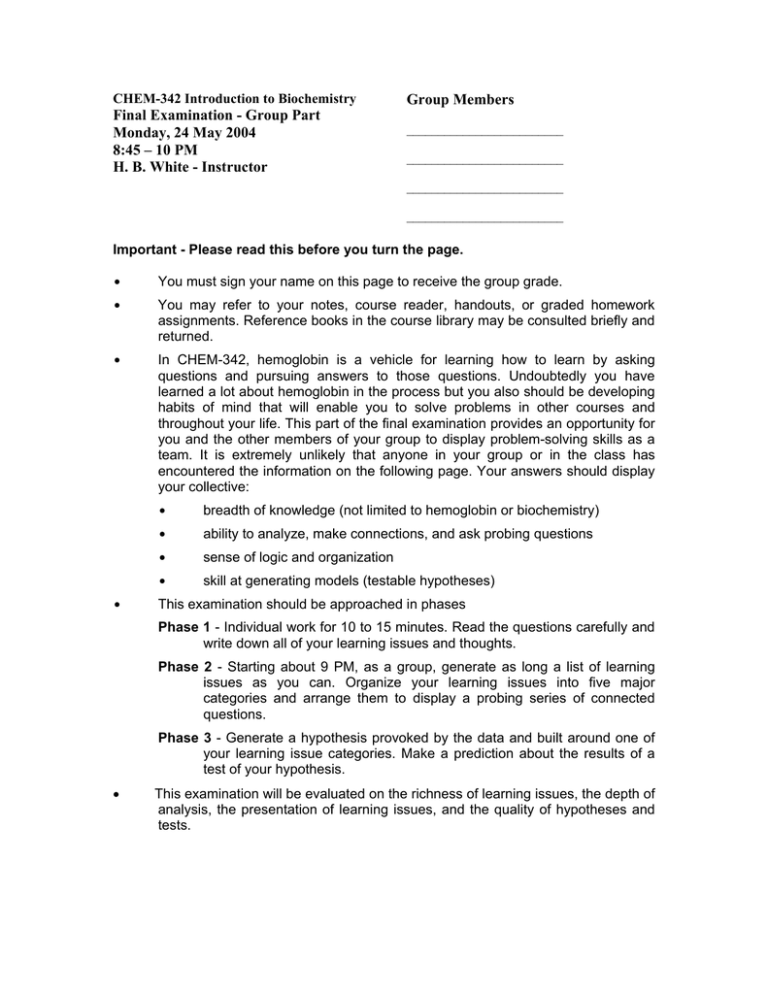
CHEM-342 Introduction to Biochemistry Final Examination - Group Part Monday, 24 May 2004 8:45 – 10 PM H. B. White - Instructor Group Members _________________________ _________________________ _________________________ _________________________ Important - Please read this before you turn the page. $ You must sign your name on this page to receive the group grade. $ You may refer to your notes, course reader, handouts, or graded homework assignments. Reference books in the course library may be consulted briefly and returned. $ In CHEM-342, hemoglobin is a vehicle for learning how to learn by asking questions and pursuing answers to those questions. Undoubtedly you have learned a lot about hemoglobin in the process but you also should be developing habits of mind that will enable you to solve problems in other courses and throughout your life. This part of the final examination provides an opportunity for you and the other members of your group to display problem-solving skills as a team. It is extremely unlikely that anyone in your group or in the class has encountered the information on the following page. Your answers should display your collective: $ $ breadth of knowledge (not limited to hemoglobin or biochemistry) $ ability to analyze, make connections, and ask probing questions $ sense of logic and organization $ skill at generating models (testable hypotheses) This examination should be approached in phases Phase 1 - Individual work for 10 to 15 minutes. Read the questions carefully and write down all of your learning issues and thoughts. Phase 2 - Starting about 9 PM, as a group, generate as long a list of learning issues as you can. Organize your learning issues into five major categories and arrange them to display a probing series of connected questions. Phase 3 - Generate a hypothesis provoked by the data and built around one of your learning issue categories. Make a prediction about the results of a test of your hypothesis. • This examination will be evaluated on the richness of learning issues, the depth of analysis, the presentation of learning issues, and the quality of hypotheses and tests. CHEM-342 Introduction to Biochemistry Final Examination-Group Part, 24 May 2004 Group number ____________________________________ Page 2 Focus in CHEM-342 has been on hemoglobin, however, it should be evident that the principles learned here apply throughout biochemistry. Rhodnius prolixus (picture on next page) is not a mosquito that transmits malaria, but it is a blood-sucking insect that transmits Chagas' disease, a deadly human disease, also caused by protozoan parasite, Trypanosoma cruzi. As stated on a University of Arizona website1, “R. prolixus is capable of ingesting 300 mg of blood in 15 min. Such high efficiency blood intake is made possible by a special mouthpart this bug has developed along with a sophisticated mechanism of avoiding host hemostatic reaction (blood coagulation, platelet aggregation, and vasoconstriction).” “R. prolixus contains in its salivary glands several pharmacologically active compounds that, when injected with its saliva into the host skin, counteract the host's hemostatic reaction, and permit the bug to minimize its probing and feeding times. Proteins found in Rhodnius saliva are responsible for its vasodilator, anticoagulant, and antiplatelet aggregation activity. Because they have been found to bind nitric oxide in their native state, and act as a storage and delivery system for nitric oxide, they have been named nitrophorins.” 2 “Nitrophorins are 20 kDa ferric hemeproteins. Saliva of the blood-sucking bug R. prolixus contains four homologous nitrophorins, designated NP1 to NP4 in order of their relative abundance in the glands. As isolated, nitrophorins contain nitric oxide (·NO) ligated to the ferric (FeIII) heme iron. Histamine, which is released by the host in response to tissue damage, is another nitrophorin ligand. Thus they act as antihistamines through strong binding of histamine released by the host at the site of injury. Nitrophorins transport ·NO to the feeding site. Dilution, binding of histamine, and increase in pH (from pH ~5 in salivary gland to pH ~7.4 in the host tissue) facilitate the release of ·NO into the tissue where it induces vasodilatation.” “3-D structures of several nitrophorin complexes are known (pictures on next page). The nitrophorin structures reveal lipocalin-like eight-stranded β-barrel, three α-helices and two disulfide bonds, with heme inserted into one end of the barrel. The heme iron is ligated to His59. The position of His59 is restrained through water-mediated hydrogen bond to the carboxylate of Asp70. The His59-Fe bond is bent ~15° out of the imidazole plane. Asp70 forms an unusual hydrogen bond with one of the heme propionates, suggesting the residue has an altered pKa.” 1 2 http://www.u.arizona.edu/~weichsel/txt/rhodnius.html http://pfam.wustl.edu/cgi-bin/getdesc?name=Nitrophorin CHEM-342 Introduction to Biochemistry Final Examination-Group Part, 24 May 2004 Group number ____________________________________ Page 3 Cartoon representation of Nitrophorin 2. Stereo view of the region around the NO-binding heme group. Anterior end of Rhodnius. CHEM-342 Introduction to Biochemistry Final Examination-Group Part, 24 May 2004 Learning Issue Category 1 Learning Issue Category 2 Learning Issue Category 3 Learning Issue Category 4 Learning Issue Category 5 Group number ____________________________________ Page 4 CHEM-342 Introduction to Biochemistry Final Examination-Group Part, 24 May 2004 Group number ____________________________________ Page 5 Testable hypothesis generated by one category of learning issues. Prediction of the results of a test of your hypothesis.

